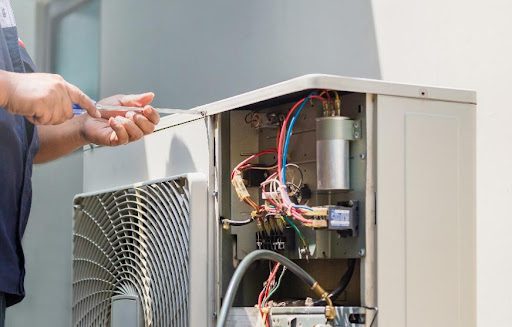There’s nothing more frustrating than coming inside to beat the scorching summer heat, only for your air conditioner to abruptly shut off – again and again. You reset the tripped circuit breaker hoping for relief, but it keeps tripping minutes later, leaving you melting in the sweltering temps. This cooling crisis doesn’t just ruin your comfort, it can seriously damage your HVAC system if the underlying problem isn’t resolved quickly.
Before you find yourself stuck sweating it out, understanding why air conditioners repeatedly trip breakers is key. This guide dives into the most common offenders behind this maddening issue. From electrical faults and blocked airflow to frozen components and undersized units maxed out under extreme loads – several potential culprits could be forcing your AC into that breaker-tripping loop.
We’ll walk through diagnostic steps to identify what’s happening, plus preventative tips to avoid cooling interruptions during the peak heat months. Don’t suffer through an indoor sauna – get that air conditioner reliably running again by tackling the core issue head-on. Reclaim that refreshing chill your home deserves.

Understanding Circuit Breakers
To get why your AC keeps cutting power, you first need to know how circuit breakers operate. These small switch devices automatically break a circuit when the electrical current gets too high – shutting things off before overloads can spark bigger issues.
Take a peek at your home’s electrical panel. You’ll see rows of breakers there, each one controlling power flow to a different room, outlet, or hardwired appliance like your air conditioner. Every breaker has an amp rating showing the maximum current that a particular circuit can handle safely before the switch flips and kills juice as a precaution.
Air conditioners are bigger power hogs, so they need hefty dedicated circuits with higher amp ratings – typically 30 amps or more depending on AC size. When too many amps try forcing their way through, it causes that breaker to trip and shut off the unit.
The usual culprit? The AC is simply drawing more electrical current than that circuit can provide, resulting in an overload scenario. But breakers also trip due to short circuits, ground faults, arcing problems, and other electrical gremlins that enable excessive current flows.
While losing power may seem like a hassle, that tripped breaker is actually doing you a favor by cutting things off before potential fire risks or equipment damage occurs. If you keep experiencing nuisance trips though, it means there’s an underlying issue that needs professional diagnosis and repairs ASAP.
Common Reasons Why ACs Trip Circuit Breakers
Sure, your AC’s circuit breaker serves an important safety role by cutting power before electrical overloads can spark real dangers. But when that breaker keeps tripping over and over, it points to an underlying issue you can’t just keep brushing off. From airflow restrictions and refrigerant problems to faulty components and inadequate circuits – several common culprits could be repeatedly forcing your cooling system into that overload territory.
Overloaded Circuit
This one’s the most obvious – your AC unit is simply demanding more electrical current than that circuit can consistently provide. Trying to force too many amps through undersized or aging wiring creates a classic overload scenario that triggers breaker trips as a preventative measure. Undersized conductors, loose connections reducing current capacity, and running too many high-draw appliances on the same circuit can all contribute.
Dirty Air Filters
It’s amazing how much strain accumulating dust and gunk can place on your AC system over time. When air filters become clogged, it restricts airflow through the indoor unit – obstructing that critical heat transfer process from happening efficiently. With less cool air circulation, components like the blower fan motor end up working overtime, drawing excessive electrical current that can quickly overload circuits.
Refrigerant Leaks
refrigerant is the lifeblood enabling your whole air conditioning cycle to transport thermal energy out of your home’s interior. When leaks develop, refrigerant levels drop – making the whole system work a lot harder to achieve the same cooling output. Those diminishing returns translate into increased electrical consumption and higher current draws that can overload breakers. Recharging and sealing leaks resolve the excess amperage issue.
Blocked Condenser Coils
Over in the outdoor condenser unit, those coils play a vital role in rejecting absorbed thermal energy outdoors. But when dust, grass clippings, shrubbery, or other debris accumulates around those coils, it obstructs airflow – dramatically reducing heat dissipation efficiency. Just like on the indoor side, those blocked coils force your AC system to work harder, drawing more amps until circuits become overwhelmed.
Faulty Capacitors
On the electrical side, capacitors act like temporary power reserves – providing torque to get hardworking compressor and condenser fan motors spinning those heavy-duty components when first starting up. When capacitors degrade or fail, those motors struggle to turn over properly which creates massive current spikes capable of overwhelming circuits instantly. Replacing worn out capacitors eliminates another potential breaker trip trigger.
Short Circuits
One of the scarier electrical gremlins that can force breakers into bodyguard mode? Short circuits – when hot wires accidentally make contact with neutral conductors or grounding sources. This abnormal low-resistance connection allows intense current surges to overwhelm circuits in a split second before breakers can react. Damaged wiring insulation, loose terminals, and exposed conductors enable these direct short-circuit paths to form.
Motor Issues
Those energy-guzzling compressor and fan motors are the real workhorses powering your AC through those critical cooling cycles. But when motor bearings wear down or windings short out, it creates internal friction that demands excess current to maintain operation. Add in decades of insulation breakdown and you’ve got a recipe for AC motor faults capable of easily overloading circuits until that breaker pulls the plug.
Loose Electrical Connections
Speaking of loose terminals, these create another current overconsumption headache by generating excessive heat at connection points. As conductors oxidize over time and connections loosen up, more resistance increases current demands. Those hot spots elevate fire risks too if left unresolved. Periodically tightening terminals and cleaning connections eliminates one more potential breaker trip trigger.
Grounded Compressor
Here’s an odd one – if your AC’s compressor motor accidentally gets grounded to its housing, it can enable stray current to flow through that unintended ground path. Not only does this increase current draw on circuits, but it also energizes exterior metal components creating a shocking safety hazard! Severed or damaged insulation between motor windings and the compressor shell usually allows these grounding faults.
Thermostat Problems
That humble wall-mounted thermostat may seem like an unlikely suspect for breaker trip episodes. But if that thermal sensor mistakenly reads inaccurate temperatures, it can continuously signal your system to run when it shouldn’t – overworking parts until circuits become overwhelmed. Thermostats can also electrically short out or develop software glitches similarly enabling those constant cooling mode commands.
Clogged Air Ducts
Don’t just consider filter buildup – the ductwork circulating all that cooled air can get obstructed too. Over years of dust accumulation, dents from household renovations, or critter invasions, those air ducts can become significantly blocked. Restricted airflow has the same impact as clogged filters – forcing blowers and condensers to labor harder drawing excess current until breakers throw in the towel.
Undersized Circuit Breaker
Alternatively, sometimes the breaker itself winds up underrated for an AC’s actual electrical demands. Homes expand over decades with extra rooms or appliances added to circuits not originally designed for those loads. If you’ve got an older home with too small a breaker protecting that now-oversized cooling system, nuisance trips become inevitable until an electrician resizes it appropriately.
Electrical Overload from Other Appliances
Remember, that circuit breaker doesn’t just protect your AC – it handles current loads from every outlet, light fixture, and device operating on that same branch circuit. Running too many high-wattage appliances like space heaters, ovens, and dryers simultaneously in addition to your cooling system can max out even properly sized breakers.
Old or Worn-Out AC Unit
At a certain point, even the best-maintained air conditioners simply reach the end of their expected service life. As compressors deteriorate, insulation breaks down, and parts like capacitors degrade over a decade or more, their energy inefficiency continually rises. An aging AC gradually draws more amps every season until even properly rated breakers give out regularly.
Fan Problems
Don’t overlook those crucial blower and condenser fans! When their motors start failing, blades get obstructed, or fan speeds reduce from slippage or control issues, it demolishes overall system airflow and heat dissipation. Just like clogged filters, the diminished airflow increases amperage demands across multiple components until the excessive current consumption hits a breaking point.
From electrical hazards and mechanical breakdowns to airflow restrictions and refrigerant problems – a variety of AC system failures can create current consumption levels high enough to persistently trip circuit breakers. Identifying the root cause requires close inspection, as every unnecessary breaker trip increases fire risks while wearing down components faster. Don’t ignore those persistent power interruptions!
Diagnosing the Problem
Sure, that tripped circuit breaker may just be an annoyance forcing you to go reset it over and over. But brushing off those persistent power interruptions as a mere inconvenience could be putting you and your home at serious risk. Underlying issues like electrical hazards, mechanical failures, and airflow obstructions frequently hide behind repetitive breaker trips.
Rather than just kicking that AC back on and hoping for the best, you need to play detective and get to the root of what’s causing those dangerous overload conditions in the first place. Left unchecked, excessive current consumption drastically increases fire risks and accelerated component wear. Solving the head-scratcher is the only way to reliably restore safe system operation.
Start With the Simple Stuff
Like any good investigation, begin by eliminating the easy potential culprits first before moving onto more complex scenarios. Thermostat glitches providing faulty run signals or incorrect programming represent a good starting point to check.
Next, closely inspect all accessible components and air pathways searching for obvious obstructions or damage. Clogged filters, coils caked in dirt/debris, or bent fan blades could be strangling airflow and forcing that AC into overdrive. Check electrical connections too – tightening any loose terminals or cleaning oxidized surfaces may already reduce resistance cutting current demands down.
Monitor for Recurring Issues
Assuming no glaring issues jump out, you’ll need to keep a vigilant eye out for patterns spotlighting when those breaker trips tend to occur. Is it only happening during peak afternoon heat when cooling demands max out? Or after the system runs for extended periods? Consistent times could indicate heat-related failures or overworked components.
Inspecting that outdoor condenser unit while paying close attention to potential hot spots along the refrigerant line set can also yield clues about capacity issues or airflow restrictions externally. And don’t underestimate the power of sound – any abnormal whirs, rattles, or buzzes from blower motors, compressors or other mechanicals could preempt potential breakdowns too.
When to Call a Professional
For the avid DIYer comfortable with basic AC maintenance like filter changes and cleaning coils, those preliminary diagnostic steps provide a solid starting point for pinpointing breaker trip culprits. There are limits though to what homeowners can safely check themselves without proper training or equipment.
If your hunting turns up any suspected issues with the electrical system, capacitors, refrigerant lines or compressor, it’s time to call in a certified HVAC professional. These technicians carry the expertise and specialized tools like multimeters to accurately troubleshoot those complex potential problems lurking behind circuit breaker failures.
The same applies if your preliminary inspections simply turn up zero conclusive evidence – an experienced set of eyes can frequently identify obscure issues you may easily miss. With the number of potential hazards from fire risks to fatal shocks, trusting the real diagnostic heavy lifting to licensed pros ensures your family’s safety and proper system fixes.
An ounce of prevention through diligent maintenance and monitoring pays major dividends in avoiding those disruptive breaker trips to begin with. But when they do occur repeatedly, thorough diligent diagnosis represents the only way to accurately find effective resolutions – rather than just Band-Aid temporary patches creating bigger future headaches. Don’t let underlying problems fester!
Preventive Measures
An ounce of prevention is worth a pound of cure – and that saying definitely applies when avoiding nuisance AC circuit breaker trips. While troubleshooting overload conditions is step one, implementing some preventative best practices provides the best defense against future power interruptions.
Even a well-maintained cooling system cycles electrical loads hundreds of times per season. That constant operation coupled with extreme outdoor temps pushes components to their limits. It’s only a matter of “when” not “if” excessive current demands or electrical faults occur without proper preemptive care. Catching small issues early prevents bigger hassles down the road.
Routine Professional Tune-Ups
Having your system professionally serviced annually should be preventative measure #1. These tune-ups by certified HVAC techs allow for thorough inspections, testing, cleaning, and recalibrations to identify and resolve any budding failures before triggering breaker overloads. The meticulous process covers filter replacements, coil cleanings, refrigerant checks, electrical tests, thermostat calibrations, and more. While an investment, it’s marginal compared to total system replacement costs.
Airflow Vigilance
Maximizing airflow is crucial. Check filters monthly, swapping them when dirty. Use vacuums and rags to clear dust and debris around indoor/outdoor coil fins and blowers. Consider coil cleaner products for stubborn gunk. Keep vents and ductwork clear of obstructions like furniture, toys, or pet accessories too.
Monitor Energy Usage
Watch for rising utility bills signaling developing electrical issues increasing current demands. Consider an energy monitoring tool tracking real-time power draw data to catch spiking wattage demands early before breakers get overwhelmed.
Being proactive about maintenance and monitoring AC energy use enables preemptive repairs before persistent inefficiency causes disruptions. Don’t burn money reacting to emergencies!
Don’t Get Left Out in the Heat – Trust Bassett for Reliable AC Repairs
Whether your air conditioner keeps tripping breakers due to an electrical issue, airflow restriction, or failing component, one thing’s certain – you can’t afford to let the underlying problem persist. Unresolved overload conditions not only leave you sweltering through the dog days of summer but also risk accelerated system breakdowns and potential fire hazards from excessive current draws.
Accurately diagnosing the root cause and implementing proper fixes requires the expertise of trained professionals. For homeowners throughout Ohio and Indiana, that means turning to the unmatched cooling repair experts at Bassett Services.
With over 40 years of experience, Bassett’s certified HVAC technicians wield the latest diagnostic tools and hands-on skills to quickly identify air conditioning faults lurking behind circuit breaker failures. Our meticulous inspections ensure no potential issues go unresolved – from refrigerant leaks and compressor failures to electrical gremlins and airflow obstructions. You can count on long-lasting solutions, not just temporary band-aid fixes.
But Bassett doesn’t stop at just reactive repairs either. Our team prioritizes preventative maintenance services aimed at maximizing AC longevity while minimizing operational headaches and premature system replacements. Through comprehensive annual tune-ups covering everything from coil cleanings and filter replacements to electrical testing and thermostat calibrations, we’ll ensure your cooling system remains poised to operate at peak energy efficiency for years.
Most importantly, Bassett backs its family-friendly expertise with resolute customer focus – providing professional service, transparent upfront pricing, and convenient payment options on every job. When your home’s comfort is on the line, you deserve a proven HVAC partner you can trust without reservation.
Don’t resign yourself and your family to sweltering through persistent cooling disruptions another day. Call the reliable professionals at Bassett Services at (317) 360-0054 to get that air conditioner running reliably again!





